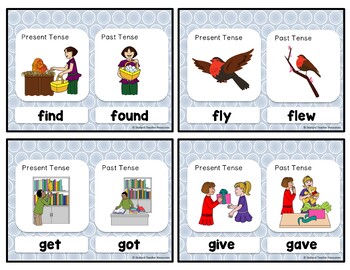

Language and Cognitive Processes, 10, 425–455.īybee, J., & Moder, C. Syntactic persistence in language production. Chicago: University of Chicago Press, 1966.īock, J. Reprinted in readings in linguistics I ed. The child’s learning of English morphology. Semantic density and past-tense formation in three Germanic languages. English Language and, Linguistics, 15, 85–112.īauer, L. variation in British English irregular verbs: The case of past tense sang vs. Children’s judgments of regular and irregular novel past-tense forms: New data on the English past-tense debate. analogy in English past tenses: A computational/experimental study.

As a result, Experiment 2 was redesigned, and data were coded, as described above, according to the morphological relation of each verb to the verb immediately preceding it.Īlbright, A., & Hayes, B. In addition, for the remaining 24 participants, another 25 % of the data, 286 of the 1,152 potential blocks, had to be eliminated. Eliminating blocks containing errors then led to the elimination of seven participants for whom there were fewer than 25 responses in a condition once blocks containing a non-technical error were eliminated. Because the presence of an error would diminish the advantage inherent in sub-regularity, any block containing an error had to be eliminated. What was unexpected was the number of errors participants made even when a verb’s sub-regularity had been primed by the verb immediately preceding it. On the assumption that priming would occur from one item within a sub-regularity to the next, we had originally hypothesized that participants would show speeded responses over the course of a block. In the original design of Experiment 2, stimuli were to be presented in small blocks of similar verbs, varying from two to five items: for regular verbs, those exhibiting the same allophone and for irregular, those following the same sub-regularity. Participants’ uncertainty about the correct form of the past tense led to the redesign of the Experiment 2. Results showed a trend towards slower RTs when past tense forms from different sub-regularities follow one another, suggesting interference between one sub-regularity and another. The second experiment tested whether the response time advantage found for blocked regular verbs in the first experiment might also extend to irregular verb forms exhibiting the same sub-regularity (e.g., sing-sang may prime ring-rang). Blocked presentation results showed longer RTs for the elicitation of irregular pasts than for regular pasts however, there were no differences between regular and irregular elicitation when the presentation was randomized, indicating that it is rules that are being primed. The first experiment addressed the methodology of presenting regulars and irregulars in blocked form as in a previous study (Jaeger et al. Two reaction time experiments investigated the production of the past tense in English in response to the auditory presentation of the present tense of the verb.

Here’s a list of the List of Irregular Verbs in English A1 – A2 level for students at A1/A2 Level in English.Opposing views of storage and processing of morphologically complex words (e.g., past tense) have been suggested: the dual system, whereby regular forms are not in the lexicon but are generated by rule, while irregular forms are explicitly represented the single system, whereby regular and irregular forms are computed by a single system, using associative connections and a system whereby phonological rules relate both regular and irregular past to present tense forms. I would recommend to students who are not studying for an exam, to start out by trying to memorise the past forms of only the verbs that they are already familiar with. This makes them easier to remember and can be particularly useful when students need to study a long list of verbs in the past form to pass an exam. While there are many irregular verbs in the past, many can be placed into phonetic groups.

Students are always daunted by the seemingly endless list of irregular verbs in the past in English.


 0 kommentar(er)
0 kommentar(er)
